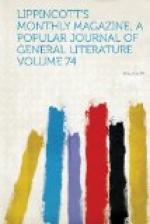In addition to the large collection of costly books of art with which this library is enriched, there are some of the rarest manuscripts and earliest printed books to be seen kept in glass cases in the Middle Hall. Among these may be mentioned the superbly illuminated manuscript of the ninth century entitled “Evangelistarium,”—one of the finest existing productions of the revival of learning under Charlemagne; the “Sarum Missal,” a richly-emblazoned manuscript of the tenth century; some choice Greek and Latin codices once belonging to the library of Pope Pius VI.; and the Persian manuscripts recently acquired, which formerly were in the library of the Mogul emperors at Delhi, bearing the stamp of Shah Akbar and Shah Jehan. The writing is by the famous calligrapher Sultan Alee Meshedee (896 A.H., or 1518 A.D.).
There is as great a popular misconception of the character and purpose of the Lenox Library as of the Astor. The two are like and yet unlike,—alike in the rich treasures which they contain, but quite unlike in their scope and purposes. In reality the Lenox is a museum of art rather than a library: its books are, with few exceptions, rarities, “first editions,” illuminated manuscripts, specimens showing the advance of the typographic art from the beginning, books of artistic interest, and works not to be found in this country, and sometimes not in Europe. Its collection of paintings and sculpture is important as well as its literary treasures. It is not a library of general reference, though many of its works will be sought by scholars for the value of their contents: it is, in short, a private art-gallery and library thrown open at stated times and under certain restrictions to the public. The library owes its existence to the munificence of Mr. James




